Gupta Empire – Golden Age of India: History, Expansion, Major Rulers, Administration & Decline
The Kushanas and the Satvahanas became weaker in the middle of the 3rd century after providing 200-year-long political and economic stability. Then, after a brief period of confusion, Guptas emerged on the scene in North India and Vakatakas in South India.
The Guptas were initially subordinates of a later Kushanas branch ruling in northwest India. They gained independence in the second decade of the 4th century CE and kept north India politically united for more than a century, from CE 335 to 455.
The Guptas may have been of Vaishya origin. They had their capital at Pataliputra. The royal emblem used by the Gupta empire was Garuda.
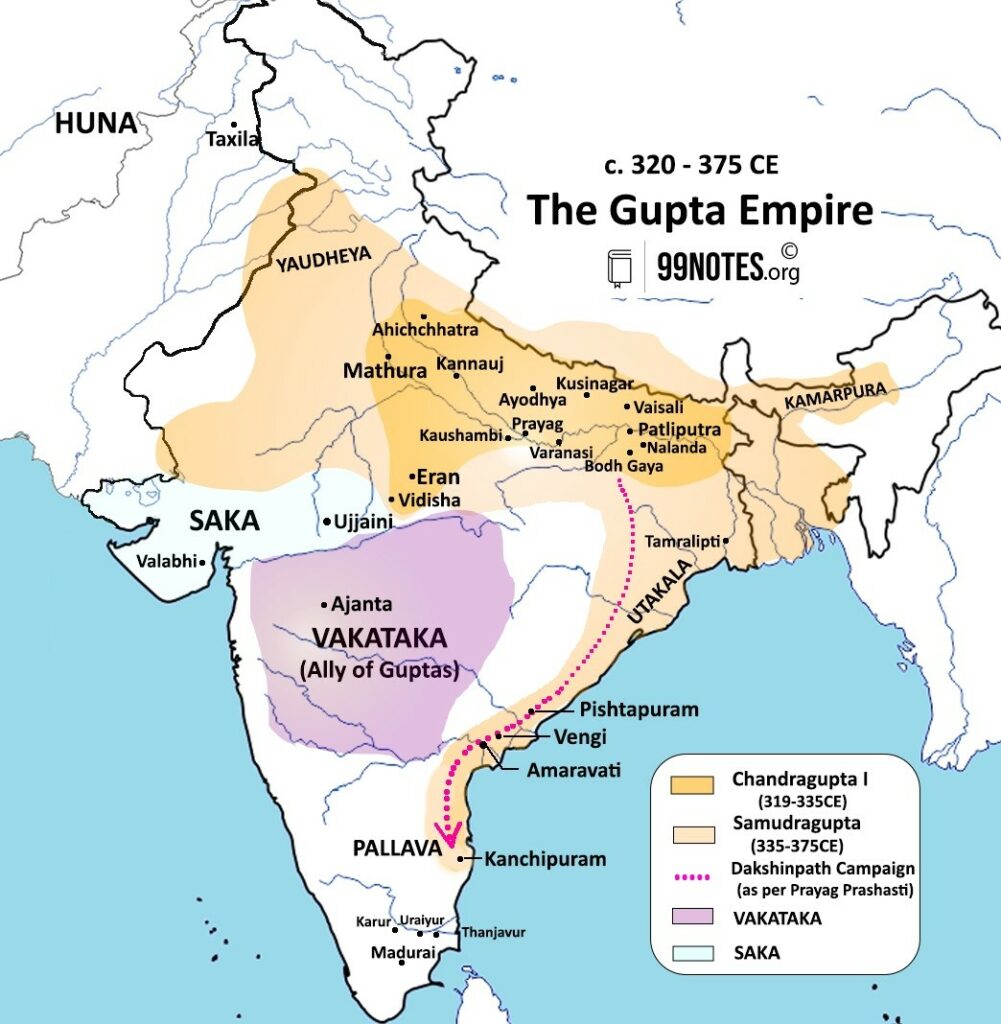
| Kings | Their rule |
| Sri Gupta (240-280AD) |
|
| Chandragupta- I (319-335AD) |
|
| Samudragupta (335-375AD) |
|
| Chandragupta – II (380-412AD) |
|
| Kumargupta I (415-445AD) |
|
| Skandagupta (455-467AD) |
|
- The later Gupta turned out to be weak and couldn’t deal with the rising powers of the Hunas. The last ruler of the Gupta Empire was Vishnugupta.
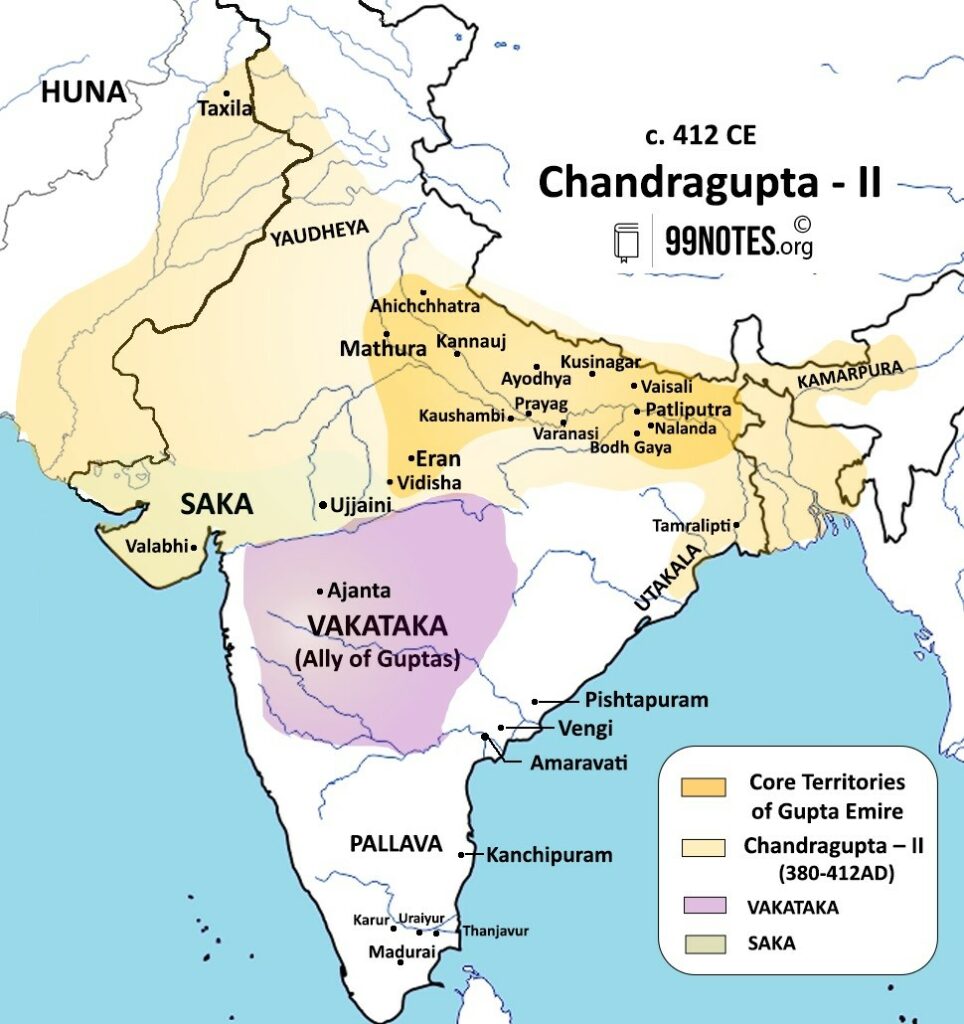
Administration during the Gupta empire:
- The Gupta Empire was divided into 26 Bhuktis (Provinces), which were at times under the charge of princes.
- The provinces were further divided into Vishaya(Districts), Vithi(Sub-districts) and Grama (villages).
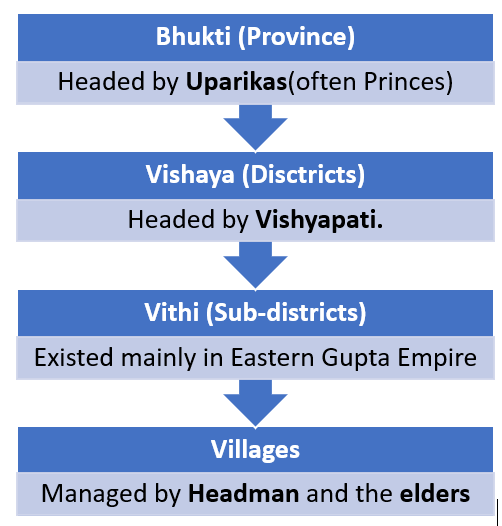
- Various new officers and departments emerged during the Gupta Age.
| Important officers | Features |
| Kumaramatyas |
|
| Sandhivigrahika |
|
| Dandapashik |
|
| Sarvadhyaksha |
|
- Administrative posts became hereditary during the Gupta period. One person could have many offices under him at times.
- Due to the feudal setup, Important men often influenced the local administration.
The Growth of Feudalism:
- Cavalry was an essential element of the Gupta army. Chariots do not figure prominently during this time.
- The royal army was supplemented by the militia of feudal chiefs (Samantas) who were not paid in cash but received land grants.
- In a later period, Samanta grew powerful enough to set up independent kingdoms.
- The adoption of titles such as Adiraja and Maharajadhiraja gives a sense that a Gupta king was a king over many feudatory kings.
Economy: The Golden Age of India
- The Gupta Age is known as the Golden age of India because the Guptas issued the most significant number of Gold coins in Indian history.
- However, the use of cheaper metal coins (such as copper coins) decreased. It means that the ordinary people, who did not transact in gold, shifted to the Barter system.
| Coins | Features |
| Dinar | These were gold coins.The quality of gold coins deteriorated. |
| Rupaka | These were silver coins16 Rupaka = 1 Dinar |
| Daler | These were copper coins |
- Each Gupta ruler issued many types of gold coins – Marriage coin, Ashvamedha coin, Archer type, Rhino slayer type, lion slayer type, Horse rider, Elephant rider, War coins etc.
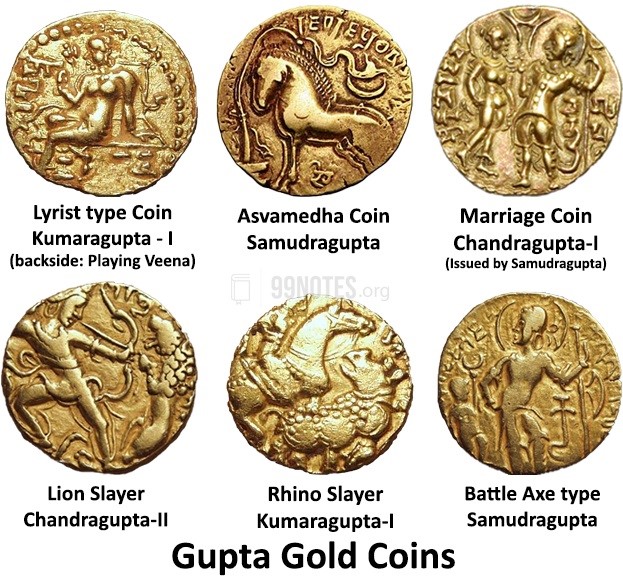
Source: CoinIndia ,Coin , Wikipedia
Taxation
- Land Revenue was called Bhaga or Bhoga, which could be Paid in cash. It was the primary source of revenue for the empire.
- Inscriptions from Madhya Pradesh and Kathiyawar suggest that Vishti (Forced labour) was a reasonable means of tax collection.
- The Brahmans were provided with Tax-free grants. In return, Brahmanas often compared the king to Gods.
Trade and Commerce:
- Trade and commerce seem to have declined during this period.
- Commercial taxes are not found prominently in this period. We find little mention of the sales tax, excise or customs duty, as was in the Mauryan and Kushana times.
- The decline of the Silk Route: The Eastern Roman empire’s control over the silk route declined. With fragmented control over the trade route, peaceful trade got hampered. This led to a decline in foreign trade through land routes.
- The reduced number of copper and silver coins indicates a shift towards the Barter system.
- It was majorly an agrarian society.
- We find the mention of several new terms in the economic context during the Gupta Age.
| People | Trade |
| Nagaram | Nagaram was the organization of merchants that wealthy landowners and merchants controlled. |
| Nagara-shreshthi | Chief banker/merchant of the city |
| Sarthavaha | Merchant caravan |
| Pratham-kulika | Chief craftsman |
Law and justice during the Gupta empire
- The Gupta period is considered a milestone in the administration of law and justice.
- There was a clear distinction between Civil Law and Criminal Law.
- The legal system in this era was derived from contemporary legal literature. For example, the Dharmasastras of Manu, Yajnavalkya, Narada, Brhaspati, and Katyayana were written during the Gupta period.
- The Civil law included the laws on marriage, inheritance and occupations, which were derived from the above smritis.
- Thus, the power to impose legal sanctions in the Gupta age derived from the scriptures, limiting the absolute power of the monarchy. This is in contrast with the Mauryan times, where Arthashastra made the king an ultimate authority in legal affairs.
The decline of the Gupta Empire
- Skandagupta(455-467AD) was the last of the great Gupta rulers before the empire’s collapse. The last ruler of the Gupta Empire was Vishnugupta (540 –550AD).
The Huna invasions
- During Kumaragupta-I’s (415-455AD) rule, the northwest borders had been threatened by the Hunas, a Central Asian tribe.
- Skandagupta(455-467AD) repelled several Huna attacks. However, after him, Hunas successfully established pockets of rule in north-western, northern and western India.
- Around the end of the 5th century CE, the Huna chief Toramana could control large parts of western India and central India. His son Mihirakula extended the dominions, which proved to be a severe blow to the Gupta Empire.
- Mihirakula ruled from Gwalior according to the Gwalior Inscription. Buddhist texts describe Hunas as “rude and cruel” who destroyed several monasteries.
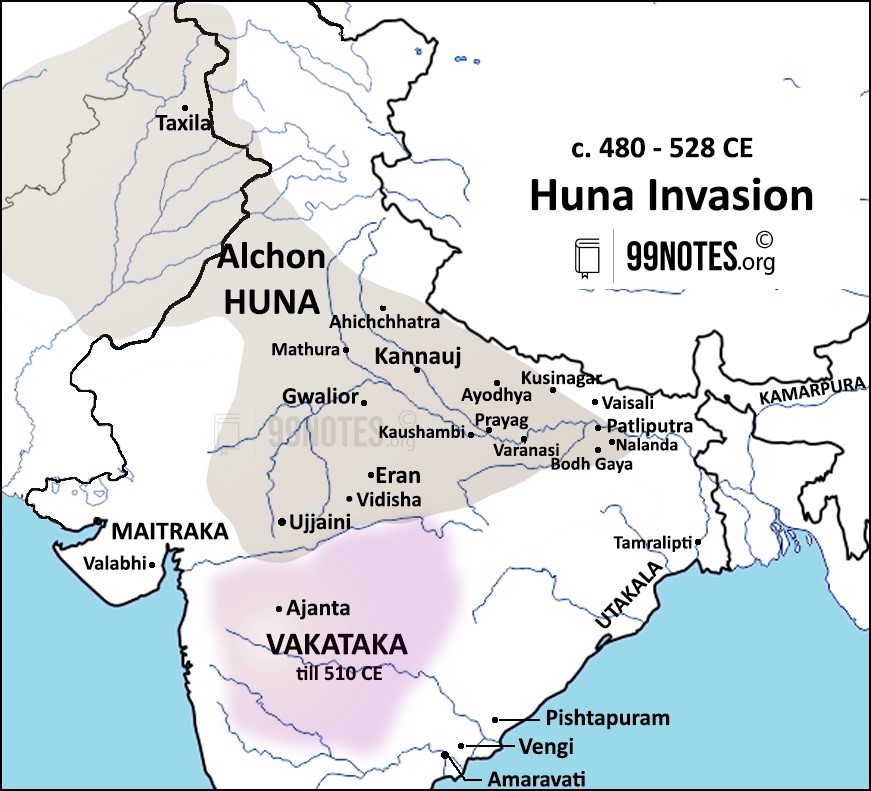
- The Huna invasion proved to be an immediate cause of the decline of the Gupta Empire. However, several other factors came into play.
Administrative Weaknesses
- Feudal Setup: The Guptas’ strategy in the conquered territories was to reinstate the power of regional chiefs or kings after they had acknowledged Gupta suzerainty. The control over the local chiefs of conquered regions wasn’t as effective, and Samanta oftenbecame very powerful and wielded independent authority.
- Aggressive Expansionism: Reinforcing the authority of the Gupta Empire through conquest depleted their treasury and goodwill.
- No direct control over revenues: The devolution of taxation powers to feudal lords prevented direct access to the revenue from the far-off lands. Further, the practice of granting tax-free land to the Brahmans started in this age.
- The succession Crisis: Whenever there was a succession crisis, the local chiefs tried to re-establish their independent authority. Towards the end of the 5th century AD taking advantage of the weak Gupta emperors, many regional powers re-asserted their independence.
Despite the defeat of the Hunas by the host of North Indian kings in 528CE, the Guptas couldn’t recover. After the Guptas, North India split into several kingdoms, such as Maitrakas of Valabhi, Hunas in Punjab, Maukharis of Kannauj and Yashovarman of Malwa.





![Early Political Activities: 1858-1905 [Complete Notes For Upsc] | Updated May 18, 2025 Early Political Activities: 1858-1905 [Complete Notes For Upsc]](https://www.99notes.in/wp-content/uploads/2024/02/early-politics-featured-66698a6014484-768x500.webp)
